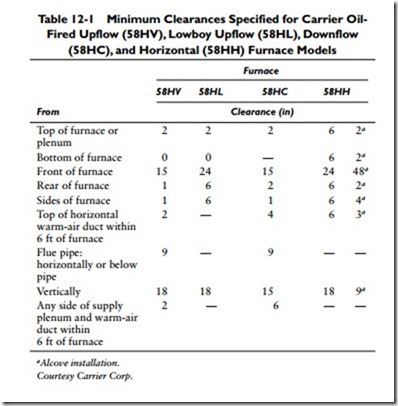Some Installation Recommendations
The installation of an oil furnace must comply with the local building codes and the manufacturer’s installation recommendations. As was mentioned at the beginning of this chapter, additional useful and important information is contained in the National Fire Protection Association’s Installation of Warm Air Heating and Air- Conditioning Systems, 2002 edition and the Standard for the Installation of Oil Burning Equipment, 2001 Edition (NFPA No. 31). The appropriate sections of the Uniform Mechanical Code, 2003 edition, should also be consulted.
New furnaces for residential installations are shipped preassembled from the factory with all internal wiring completed. The fuel supply tank must be installed and the fuel line connected to the furnace by the installer. The electrical service from the line-voltage main and the low-voltage thermostat will also have to be connected. Directions for making these connections are included in the furnace manufacturer’s installation literature.
Make certain you have familiarized yourself with all local codes and regulations that govern the installation of an oil-fired furnace. Local codes and regulations always take precedence over national standards. Read the section Installation Recommendations in Chapter 11, “Gas Furnaces” for additional information.
Location and Clearance
An oil furnace should be located as near as possible to the center of the heat-distribution system and chimney. A centralized location for the furnace usually results in the best operating characteristics because long supply ducts and the heat loss associated with them are eliminated. The furnace should be installed as close as possible to the chimney to reduce the horizontal run of flue pipe.
An oil furnace should be located a safe distance from any combustible material. Observe the minimum clearances suggested by the manufacturer for the furnace except where they may come into
conflict with local codes and regulations (Table 12-1). Local standards always take precedence over the manufacturer’s specifications or national standards. Where there are no local standards specifying clearances, use those listed in Installation of Oil Burning Equipment 1972 (NFPA No. 31-1972). Contents of the 1972 edition have been approved by the American National Standards Institute (ANSI).
Allow access for servicing the furnace and oil burner. Sufficient clearance should also be provided for access to the barometric draft-control assembly.
Wiring
Always follow all national and local codes when wiring a unit. The local code should take precedence when there is a conflict between ![]()
the two. If there are no local ordinances and codes, do all electrical wiring in accordance with the National Electrical Code (ANSI/NFPA 70-1999).
Closely follow the wiring diagrams provided by the furnace manufacturer and those who manufacture the automatic controls. Failure to do this may result in losing the factory warranty.
A typical wiring diagram for an oil furnace is shown in Figure 12-15. The comments made in Chapter 11, “Gas Furnaces” concerning line-voltage and control-voltage wiring connections also pertain to the wiring of oil furnaces.
Duct Connections
Detailed information concerning the installation of an air-duct sys-
tem is contained in the following two publications of the National Fire Protection Association:
1. Installation of Air Conditioning and Ventilating Systems of Other Than Residence Type, 2002 edition (NFPA No. 90A)
2. Residence Type Warm Air Heating and Air Conditioning Systems, 2002 edition (NFPA. No. 90B)
Additional information about duct connections can be found in Chapter 7 of Volume 2, “Ducts and Duct Systems.” The specific recommendations concerning furnace duct connections and the air- distribution ducts contained in Chapter 11, “Gas Furnaces” also apply to gas-fired furnaces.
